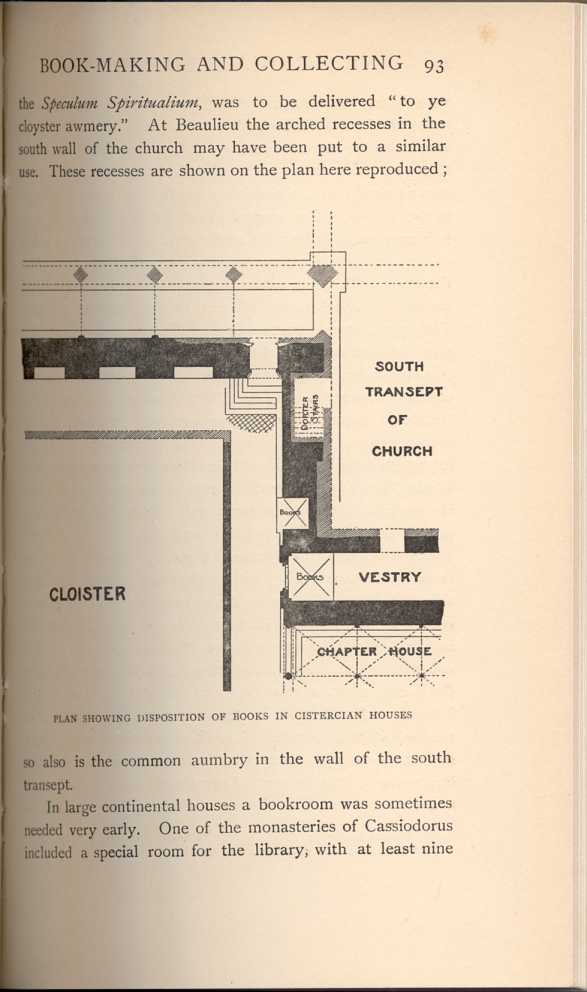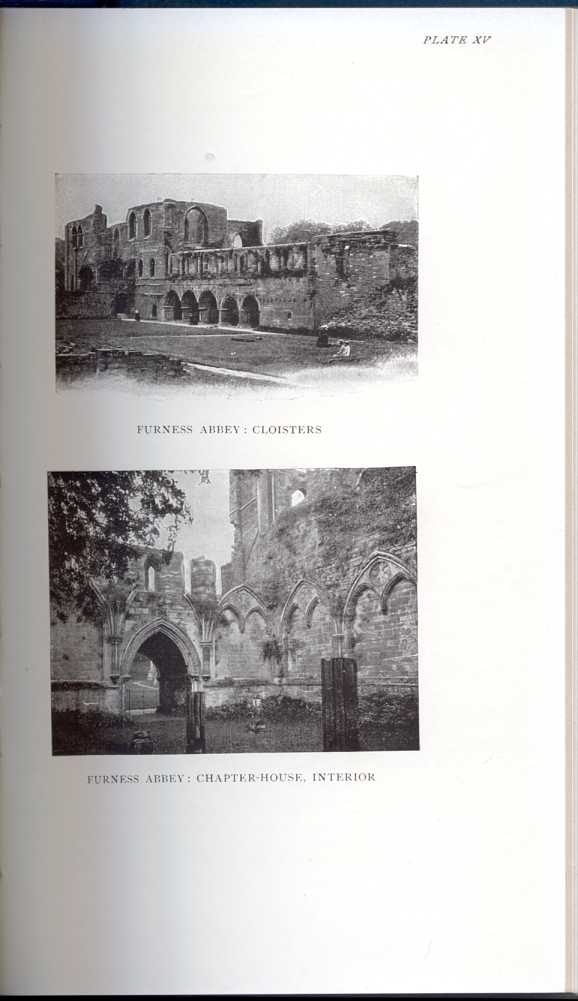| CHAPTER IV: BOOK-MAKING AND COLLECTING IN THE RELIGIOUS
HOUSES Old English libraries; the making, collection and use of books during the middle ages | ||
2. § II
Some miniatures in early manuscripts give us a good idea of the way books were stored in the Middle Ages. They are shown lying flat on sloping shelves which extend part-way round the room. Curtains are occasionally shown hanging in front of the shelves to protect the books from dust. Or a sloping shelf was fitted to serve as a reading-desk, and a second flat shelf ran beneath it to take books lying on their sides one above the other. In several miniatures lecterns of very curious design are often depicted; some of them stood on a cupboard or cupboards wherein books were stowed away.
In the monasteries books were stored in various places, —in chests, cupboards, or recesses in the wall. When the collection was small, a chest served; a receptacle of this kind is illustrated at p. 50. Cassiodorus had the books of his monastery stored in presses, or armaria. The manuscripts of Abbot Simon of St. Albans were preserved in "the painted aumbry in the church." An aumbry was a recess in the wall well lined inside with wood so that the damp of the masonry should not spoil the books. It was divided vertically and horizontally by shelves in such a way that it was possible to arrange the books separately one from al other, and so to avoid injury from close packing, and delay in consulting them.[4.55] The same term was applied to a detached closet or cupboard. At Durham the monks distributed their books—keeping some in the spendimentum or cancellary, some near the refectory, and
Along the south wall of the cloister at Chester is a series of recesses which are believed to have been used for bookcases. Two recesses for aumbries are still to be seen in the cloister at Worcester: it is recorded that one book,
 [Description: PLAN SHOWING DISPOSITION OF BOOKS IN
CISTERCIAN HOUSES]
[Description: PLAN SHOWING DISPOSITION OF BOOKS IN
CISTERCIAN HOUSES]In large continental houses a bookroom was sometimes needed very early. One of the monasteries of Cassiodorus included a special room for the library, with at least nine
 [Description: FURNESS ABBEY: CLOISTERS;
FURNESS ABBEY: CHAPTER-HOUSE, INTERIOR]
[Description: FURNESS ABBEY: CLOISTERS;
FURNESS ABBEY: CHAPTER-HOUSE, INTERIOR]At the Premonstratensian Abbey of Titchfield the books were stored in a small room, in four cases, each having eight shelves. We do not positively know that a separate room existed at the Benedictine house of Christ Church, Canterbury, before the fifteenth century, "yet," as Dr. James says, "the form of Prior Eastry's catalogue, with its division into Demonstrations and Distinctions, irresistibly suggests that the collection must in his time [1284-1331] have occupied a special room, of which the two Demonstrations represent the two sides. The Distinctions would be narrow vertical divisions of these, and each of them would have its numerous subdivisions into Gradus. As the best English equivalent of Demonstratio I would suggest the word `Display,' which fairly gives the idea of a wall-surface covered with books; and I figure the building to myself as an enlarged example of those Cistercian bookrooms with which Dr. J. W. Clark's researches have familiarized us. It would thus be no place for study, such as the later libraries were, but merely a storeroom whence books were fetched to be read at leisure in the cloister."[4.62] Between 1414 and 1443 a library was built over the Prior's Chapel by Archbishop Chichele: it was about sixty-two feet long on the north side, fifty-four on the south side, and twenty-two feet broad. This was the room which Prior Selling fitted up with wainscot, and put books in for the benefit of the studious.[4.63] At St. Augustine's Abbey, Canterbury, there was a bookroom in 1340, for the manuscript of the Ayenbite of Inwyt contains a note that it belongs to the
At Gloucester a special room was built, probably in the fourteenth century. Durham apparently did without a room until early in the fifteenth century. "There ys a lybrarie in the south angle of the lantren, whiche is nowe above the clocke, standinge betwixt the Chapter-House and the Te Deum wyndowe, being well replenished with ould written Docters and other histories and ecclesiasticall writers." [4.65] To this room the books were transferred gradually from the cloister and chancellery: the words "in libraria," or "Ponitur in libraria," being written in the margin of the catalogue opposite to the book upon its removal.
The Benedictine houses of Winchester, Worcester, Bury St. Edmunds,[4.66] and St. Albans also had special bookrooms.
For the safe keeping of the conventual books the preceptor was responsible.[4.67] As he had charge of the armarium or press for storing books, he was also sometimes styled "armarius." He was required to keep clean all the boys' and novices' presses and other receptacles for books; when necessary he was to have these fittings repaired. To provide coverings for the books; to see that they were marked with their proper titles; to arrange them on the shelves in suitable order, so that they might be quickly found, were all duties within his province.[4.68] He had to keep them in repair: in some houses he was expected to
As a rule the monks so highly prized their books— saving them first, for example, in time of danger, as when the Lombards attacked Monte Cassino and the Huns St. Gall—that rules for the care of them would seem almost superfluous. Still, such rules were made. When reading, the monks of some houses were required to wrap handkerchiefs round the books, or to hold them with the sleeve of their robe. Coverings, perhaps washable, were put upon books much in use. [4.71] The Carthusian brethren were exhorted in their statutes to take all possible care to keep the books they were reading clean and free from dust.[4.72] Elsewhere we have referred to an "explicit" urging readers to have a care for the scribe's writing: in another manuscript once belonging to Corbie, the kind reader is bidden to keep his fingers off the pages lest he should mar the
| CHAPTER IV: BOOK-MAKING AND COLLECTING IN THE RELIGIOUS
HOUSES Old English libraries; the making, collection and use of books during the middle ages | ||